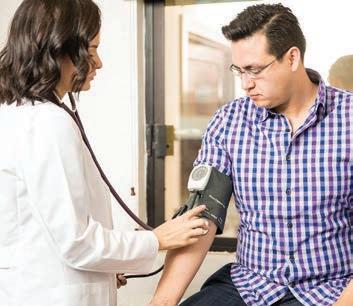












LIFE, HEALTH & WELLNESS SUMMER 2021 A PUBLICATION OF Inside Page 7 Hey Guys ... You’re Not Invincible Page 14 Roll Up Your Sleeve for the Vaccine Page 22 Out-of-Town Coverage and College Students I just want to take my time after I retire and see where each day takes me.
B., Network Health member
-Mary
EDITORIAL STAFF
President Coreen and CEO Dicus-Johnson
Chief Administrative Penny Ransom Officer
Strategic Marketing Jon Race and Communications Coordinator
Visual Design Lead Debra Sutton

EDITORIAL BOARD
Melanie Draheim, Angela Keenan, Mallory Mueller, Alice Parks, Stacy Schwandner, Romi Norton, Kimberly Swanson, Theodore Regalia, Kacey Werner, Hannah Neylon
Balance is published by Network Health. The health information contained in Balance is meant to supplement, not replace, the advice of health care professionals.
© 2021 Network Health. No portion of this newsletter may be reproduced without written permission from Network Health.

TELL US YOUR STORY
If you have questions or suggestions or would like to tell us how Network Health improved your life, send us an email at marketing@networkhealth.com You can also write to us at: Network Health Attention: Jon Race 1570 Midway Pl. Menasha, WI 54952
Monday, Wednesday–Friday: 8 a.m. to 5 p.m. Tuesday: 8 a.m. to 4 p.m.
p.m.
3 Letter from the President and CEO 4 Getting Social with Network Health 4 Do You Get Too Much Mail? 4 Submitting a Claim for Reimbursement 5 Is an Ambulatory Surgery Center the Right Choice for You? 2 | balance • Summer 2021 networkhealth.com
HAVE A QUESTION? Call our member experience team. HOURS
PLANS THROUGH AN EMPLOYER 800-826-0940 PLANS FOR INDIVIDUALS AND FAMILIES 855-275-1400 STATE OF WISCONSIN EMPLOYEES/MEMBERS 844-625-2208
4
WANT MORE HEALTH TIPS? Check out our blog at networkhealth.com/blog HMO and POS plans underwritten by Network Health Plan. Self-insured plans administered by Network Health Administrative Services, LLC. 3457-01-0521 12 Dental, Vision and Fitness Benefits for Individual and Family Plan Members 12 Evaluating New Technologies 13 Emergency Care or Urgent Care or Virtual Visit? 14 Roll Up Your Sleeve for the Vaccine 15 Achieving Coronavirus Herd Immunity Protection in Wisconsin 16 What Is Population Health Management? 16 Member Rights and Responsibilities 17 Health Care Decisions and Advance Care Planning – Why It Matters to Have It Now 18 Human Papillomavirus (HPV) Vaccine Is Cancer Prevention 19 Lifecycle of a Claim 20 Medication Adherence and Overcoming Barriers 22 Out-of-Town Coverage and College Students 23 The Importance of an Annual Wellness Visit BACK COVER Approaching 65? Network Health Has You Covered Embracing Diverse Talent COVER STORY 08 Getting Ready for a New Start – Mary’s Story 07 6 Sun Safety and Spotting Skin Cancer 7 Hey Guys ... You’re Not Invincible
Monday, Wednesday–Friday: 8 a.m. to 5
Tuesday: 8 a.m. to
p.m.
Letter from the President and CEO

Thank you for choosing Network Health for your health insurance plan. We truly appreciate the trust you place in us to be your health and wellness partner.
During the past eighteen months, our concern about our health and the health of our loved ones was amplified. We had to change our ways of operating day-to-day, and incorporated new terms in our vocabulary such as, social distancing, herd immunity and flattening the curve.
One thing that did not change—is Network Health’s focus on our mission to create healthy and strong Wisconsin communities. We embrace our Hometown Advantage™ by going above and beyond to make sure our neighbors, friends and family receive the exceptional service they want, need and deserve.
In this issue of Balance, our feature story shares how Mary Burch is getting prepared for her journey toward retirement and the decision to choose Network Health for her Medicare Advantage Plan.
Along with Mary’s story, in this issue you will find a variety of resources to help with your future health care decisions and providing awareness on several health care topics. These topics include information about vaccines, health plan processes, where and how to get care, out-of-town coverage and much more.
Network Health has put our members first for more than 38 years. Our members’ health and safety remain our top priority, now and in the years to come.
Continue to stay safe and well.
Sincerely,
Coreen Dicus-Johnson President and Chief Executive Officer

networkhealth.com Summer 2021 • balance | 3
Getting Social with Network Health
By Jordan Kapellusch, digital marketing specialist at Network Health
To support our mission of building healthy and strong Wisconsin communities, Network Health has several social media profiles allowing you to connect with us and each other. On these pages, you can contact us with questions about Network Health, our member events, the benefits of membership and more. You’ll also have access to health and wellness content that will help you improve and maintain your health.
Our Grow in the Know blog features exclusive content on a variety of health care topics. You can find our blog at networkhealth.com/blog
On Facebook, we regularly share content from Grow in the Know. In addition, you’ll find great discussions about health and wellness topics, as well as events and organizations in your community. Find us on Facebook at facebook.com/networkhealthwi
Our netwell group on Facebook is your place for connection, community and active listening regarding mental health, encouragement, self-awareness and more, without the stigma that can often accompany these topics. Visit facebook.com/groups/netwell
Our Instagram page (@NetworkHealthWI) is regularly updated and features interesting shareables, graphics, photos and videos of our Network Health values in action.
We frequently share content about health, wellness and insurance advice through our Twitter profile. We’re @NetworkHealthWI on Twitter.
LinkedIn is the place to go to see updates from our business partners and read about the events we host and attend. Learn more by visiting us at linkedin.com/company/network-health-wi
Our YouTube channel gives you access to our library of video content. It features videos covering FAQs, health insurance topics, healthy recipes and updates about our media appearances and our local business partners. We’re on YouTube at youtube.com/user/NetworkHealthWI.
Do You Get Too Much Mail?
Network Health now lets you choose which information you want to receive in the mail and which information you want to receive via email. You can go paperless for some communications and receive emailed information. Or, if there are communications you’d rather receive in the mail, you can select that preference. The choice is yours.
Select your preferences through your member portal at login.networkhealth.com. Simply log in to the portal, click your name in the upper right corner and select Change My Communication Preferences. From here, you can choose email for any or all the available categories. Make sure to click Next to save your choices.
Submitting a Claim for Reimbursement
Network Health processes claims according to state and federal time frames. Most providers will send a claim for medical services directly to Network Health on your behalf. If the provider will not bill Network Health, then you may need to pay the provider directly and obtain a completed claim form and proof of your payment. You can then submit this documentation to Network Health for reimbursement.
Note – Providing all the necessary information will allow Network Health to process the claim more quickly.
To receive reimbursement, the service must be covered under your plan and the reimbursement amount would be less any deductible or cost sharing for the services. The address for submitting a medical claim is on the back of your Network Health ID card.
lif e.
4 | balance • Summer 2021 networkhealth.com
health. wellness.
Is an Ambulatory Surgery Center the Right Choice for You?
 By Sarah Dencker, vice president of care services at Network Health
By Sarah Dencker, vice president of care services at Network Health
A
mbulatory surgery centers (ASCs) have changed the outpatient experience for a lot of people in the U.S. By providing patients a convenient alternative to hospitalbased outpatient procedures, ASCs have given people more control over their health care.
What is an ASC?
ASCs are modern health care facilities focused on providing same-day surgical care, including diagnostic and preventive procedures. This means that patients treated at an ASC do not require admission to a hospital following their procedure. Sometimes referred to as outpatient surgery centers or same-day surgery centers, ASCs do not offer emergency services and usually do not offer overnight stays.
Why choose an ASC?
ASCs and hospital outpatient departments (HOPDs) may offer identical services, but they can vary greatly in cost.
ASCs offer many of the same surgical procedures as HOPDs—joint replacement, rotator cuff repair and knee arthroscopy, as well as other services, like MRIs and injections. However, ASCs generally offer them at a significantly lower cost than HOPDs. In fact, outpatient joint replacements performed in an ASC may cost as much as 40 percent less than those performed in a hospital. Other procedures, such as rotator cuff repair and knee arthroscopy, may cost over 50 percent less.
It is important for members to understand that the quality of health care provided by surgery centers is equal to the quality of health care offered by hospitals. Keep in mind that the surgeons have the same credentials to operate in both hospitals and outpatient surgery centers. In fact, because ASCs specialize in the procedures they perform, they can concentrate on patient safety and the patient experience. ASCs also have an excellent record of safety and quality outcomes for patients. The difference in price can be attributed to how outpatient surgery centers are structured and their ability to see more patients in a shorter timeframe.
What types of procedures can be done at an ASC?
Many procedures can be safely done at an ASC. Some of the most common include the following.
• Cataract surgery
• EGDs
• Colonoscopies
• Pain injections
• Knee arthroscopies (scope)
• Total knee and hip arthroplasties (replacement)
• Carpal tunnel surgery
How can you tell the difference between an ASC and an HOPD?
A hospital outpatient department is owned by, and typically attached to, a hospital. An ambulatory surgery center, however, is considered a standalone facility.
The conclusion
Lower cost sharing is another potential benefit of using an ASC. Check your plan benefits to see if your copayments or coinsurance would be less if you were to choose an ASC for a procedure. You can also call our member experience team with questions. You can find the number on the back of your member ID card.
Ultimately, the choice is up to you whether you want to use an ASC or an HOPD for a procedure. But before you make that decision, get the information necessary to choose wisely. Check your benefit plan, consult with doctors and/or call Network Health’s member experience team to get your questions answered. Find out what’s best for you.

networkhealth.com Summer 2021 • balance | 5
wellness.
SUN SAFETY
and SPOTTING SKIN CANCER
If the sun is out, your guard should be up. Most people know that exposure to ultraviolet (UV) rays can put you at greater risk for skin cancer, the most common type of cancer. Knowing the risk of sun exposure and how to prevent its damaging effects will help you reduce your skin cancer risk.
By Morgan Radlinger, BS, CWP, lifestyle coach DPP, wellness coordinator at Network Health
Spotting skin cancer
According to the Skin Cancer Foundation, more than 9,500 Americans are diagnosed with skin cancer every day. Fortunately, if diagnosed and treated early, skin cancer is the easiest cancer to cure, so conducting regular self-examinations is important.
What are the different types of skin cancer?
The three main types of skin cancer are listed below.
• Basal cell carcinoma
• Squamous cell carcinoma
• Melanoma
Each type has different qualities, so it’s important to watch out for any skin changes. It’s also important to remember that a cancerous spot doesn’t always come with pain, so don’t ignore something suspicious just because it doesn’t hurt.
How often should I look for skin cancer?
In addition to a yearly exam from your doctor, you should check yourself once a month. If you’re new to spotting skin cancer warning signs, you might want to have your doctor do a full-body exam first. After that, a monthly self-exam should take no more than 10 minutes.
What are the warning signs?
If you notice any of these warning signs, make sure to see your doctor right away.
• A skin growth that increases in size and appears pearly, translucent, tan, brown, black or multicolored
• A mole, birthmark or any brown spot that
• Changes color or texture
• Increases in thickness or has an irregular outline
• Is bigger than a quarter of an inch
• Appears after age 21
• Itches, hurts, scabs or bleeds
• Looks like an open sore and doesn’t heal within three weeks
SUN SAFETY TIPS
Follow these essential sun safety tips to limit your UV exposure and protect you from skin cancer.
Seek shade. Staying in the shade is your best defense against UV exposure. You should be cautious in the sun between 10 a.m. and 4 p.m when UV rays are the strongest.
Lather it on. Pay careful attention to sunscreen labels and choose one with broad-spectrum protection (protection against UVA and UVB rays) and a sun protection factor (SPF) of 30 or higher.
Cover it up.
Cover your skin as much as possible when out in the sun. Clothing made of tight-woven fabric is your best choice. Special UV-filtering clothing is also available.
Put a lid on it. A wide-brimmed hat does a great job of shading your face, ears and neck from the sun.
Plan for it daily. While there are peak times and seasons when the sun is at its strongest, sun exposure adds up over time. Protect yourself from the sun in winter months, on cloudy days and even when you are only in the sun for a brief period.
lif
6 | balance • Summer 2021 networkhealth.com
e. health.
Hey Guys … You’re Not Invincible
By Jennifer Stubbe, wellness coordinator at Network Health
One of the biggest health challenges men face is their reluctance to seek care. Studies suggest men are 24 percent less likely to visit a doctor than women and only 40 percent of men go to the doctor if they fear they have a serious medical condition.

These numbers are surprising, considering men have a higher instance of heart disease and chronic liver disease. The good news is many of these potential health risks can be prevented or treated with early detection.
Take advantage of your annual visit with your personal
Try to engage in strength training exercises that incorporate all major muscle groups at least twice a week. Try to do one set of each exercise, using a weight or resistance that is heavy enough to tire your muscles after 10-15 repetitions.
Watch your waistline
According to the National Heart, Lung, and Blood Institute, if your waist measures more than 40 inches around, you are at an elevated risk of obesity-related diseases, such as type 2 diabetes, heart disease and stroke.
doctor
Your personal doctor can help monitor your weight, blood pressure, cholesterol levels and blood glucose levels—all risk factors for cardiovascular disease. Stay up to date on age-appropriate preventive screenings, like a prostate exam and colonoscopy. Some conditions don’t show early symptoms, so preventive screenings can lead to the early detection of diseases, which provides better outcomes.
Maintain a well-balanced diet Everything you eat and drink matters when it comes to nutrition, weight management and disease prevention. Making the right nutritional choices helps you be healthier now and in the future. Packaged and processed foods are often full of unhealthy fats, sugar, sodium and artificial additives. Instead of these items, consider the following.
• Fresh or frozen fruits and vegetables
• Whole-grain products
• Lean cuts of protein-rich foods such as beef, wild game, turkey, poultry or fish like wild-caught salmon
• Healthy fat sources from nuts and seeds
All of the above support your body to maintain a strong immune system, minimize inflammation and maintain prostate health.
Get up off the couch and get physical
Regular physical activity is one of the best ways to help prevent heart disease—the leading cause of death in American men. To maintain current weight and overall health, aim for at least 150 minutes of moderate-intensity aerobic activity, 75 minutes of vigorous-intensity aerobic activity or a combination of moderate and vigorous activity levels each week. To promote weight loss and increase overall health, aim for about 300 minutes of intentional physical activity per week.
The best way to get rid of excess belly fat is to improve the quality and adjust the quantity of your nutrition choices, in addition to increasing your physical activity. Talk to your personal doctor about developing a weight-loss plan that will be both safe and effective for you.
Take care of yourself
Don’t let contentment take a toll on your health. Taking care of yourself can be as simple as making healthy lifestyle choices. Consider creating or expanding your current support system to help hold you accountable to your health goals. Network Health offers one-on-one telephonic health coaching with a wellness coordinator, at no cost for our members, to discuss all topics referenced in this article.
networkhealth.com Summer 2021 • balance | 7


I just want to take my time after I retire and see where each day takes me.
8 | balance • Summer 2021 networkhealth.com
-Mary B., Network Health member
Getting Ready for a New Start
–
Mary’s Story
By Jon Race Photographs by Beth DesJardin, Trove Photography
When you talk to people who are approaching retirement, they are looking forward to the next chapter in their lives. For good reason, too.
Retirement signifies a new beginning. It’s the end of years spent working and the start of a more relaxed lifestyle. No more working 40+ hours a week. More free time to spend with family, traveling or doing anything else they want to do.
As the conversation about retirement continues, there is another topic that seems to weigh equally on their minds—the topic of health insurance and, of course, Medicare.
At that point, the mood may turn slightly. The wistful, happy thoughts about retirement change to serious questions about health and health insurance. What happens when I change insurance? What is Medicare? Where do I get it? How do I sign up for it? What do all the Medicare letters mean—Parts A, B, C and D?
This is exactly what Mary Bruch and her daughter, Kelli Vanderwielen, are going through right now.
On the surface, retirement may not seem all that relevant to our Balance readers. However, though retirement and Medicare may be far way away for you personally, chances are there is someone in your life who will be dealing with it sometime soon, such as a parent, sibling, aunt or uncle. Just like Mary and her daughter Kelli.
networkhealth.com Summer 2021 • balance | 9
“I want my mom to look forward to retirement and not have to worry about the decision of her health insurance getting in the way of that,” Kelli said. “I just want to make sure she feels really good about her health insurance and her retirement. She’s worked so hard to get to this point and deserves to enjoy each step of the journey.”
About Mary
Mary has lived in Little Chute, WI, for the past 34 years. She is retiring in August, which is something she has thought about off and on throughout her career as her coworkers have retired.
“I was always the youngest one at the bottom of the totem pole. I have so many great memories of friends I worked with in the past who retired,” Mary said. “So, it’s been something I’ve thought about here and there. You just don’t think about it being you who’s retiring. And, now I just can’t fathom that I am at the top of that totem pole, getting ready to leave. In my head, I’m still 25-years old … I just can’t believe I’m at that point.”
For 38 years, Mary has worked as a dental assistant. “For the most part, I hold patients’ hands. I’m there to comfort and take care of them,” Mary said. “Actually, what I really do is vacuum spit all day,” she adds laughing. “But seriously, I work beside my doctor and try to keep our patients comfortable and relaxed.”

Mary is also a licensed massage therapist. She went back to school when she was 40 years old, earned her license and started her own side business. She entertained thoughts of continuing that practice after she retires from her dental assistant duties, but the coronavirus pandemic made her change plans. “I decided to let my little office suite go and I packed my table up. It’s in my trunk, so whenever my friends or family want a massage, I’ll just go to their house and do it,” Mary said.
Like most people, Mary is looking forward to her retirement, but she’s also a little nervous. “It’s bittersweet and I don’t know how I’ll adapt to not getting up every morning at five o’ clock to get to the office by seven. Maybe I’ll just have a cup of coffee in my PJs and just cruise into each day. I just want to take my time after I retire and see where each day takes me.”
10 | balance • Summer 2021 networkhealth.com
-Kelli V., Mary’s daughter
“I just want to make sure she feels really good about her health insurance and her retirement.
Medicare
Many people who start looking at Medicare—whether they are looking for themselves or a family member—have a lot of questions. Mary’s questions include the following.
• Do I get a choice of my doctor?
• Are there copayments?
• What are the out-of-pocket costs?
• Do I get coverage for life or is it something I have to renew every year?
• Are there deductibles?
• How do Network Health and Medicare work together?
To Mary’s credit, she’s taking a proactive approach and is in a good spot. She may have numerous questions, but she is very early in the process and has time to get the information she needs and wants, so she can decide what’s best for her.
Deciding what to do, and how, is a concern of many people approaching Medicare eligibility. Figuring out the details of Original Medicare and the other Medicare options that are available is not an easy task. Further muddying the waters is the amount of advertising you may receive as your 65th birthday approaches.
“If I could change anything, it would be the flood of information I get in the mail. There’s so much of it. And it doesn’t really say anything,” Mary said. “Every day in the mail—and I can say this honestly—I get these cards from different companies about signing up with Medicare or information about a supplement or Medicare Advantage plans. It can be really confusing because there’s a lot of companies out there that do this kind of thing.”
Her daughter agrees. “It is a decision you have to make, but it is almost forced through those postcards she’s getting in the mail, and the TV ads. There’s fear, I think, that comes along with that.”
“It’s hard to find the right people to answer the questions,” Kelli continued. “My mom’s lucky because I can help her. But where does somebody go who doesn’t have the resources my mom has or someone to help them? Where do they go? How do they find answers to their questions?”
Do You Have Medicare Questions?
If you or someone you know is approaching 65 and has questions about Medicare or Medicare coverage options, you can get the answers you need by taking any of these actions.
1. Visit networkhealth.com/medicare/navigating-medicare to sign up for a free virtual Navigating Medicare educational meeting.
2. Visit networkhealth.com/medicare/new-to-medicare and sign up for The Next Chapter monthly newsletter, which walks you through the Medicare enrollment process, step by step.
3. Call a local Network Health Medicare advisor at 866-755-5233, Monday–Friday, 8 a.m. to 8 p.m.
Choosing Network Health
Turning 65 in August, Mary has already decided to go with Network Health for her Medicare Advantage coverage. “I guess I must not have paid attention before when people talked about insurance, but I have so many friends and family that have Network Health Medicare Advantage Plans. And they’re all so happy with it. That was enough for me.”
Mary continued, “Now I just have to go through the process to figure out how I am going to make Network Health my insurance.”
Mary has some time to decide exactly which Network Health Medicare Advantage Plan she wants, and she plans to go through all the details to make sure she gets exactly what she needs. Kelli will be at her side helping with the process any way she can.
“Luckily, we had networkhealth.com to go to,” Kelli said. “It’s beautifully laid out and all the questions and answers are right there.”
With her Medicare insurance questions well in hand, Mary now can direct her focus toward other aspects of her retirement. “I have two beautiful children and four grandchildren. With my significant other, Doug, we have five more added to that, so it’s a big family all together. Doug and I just got e-bikes. They’re such a blast. And, I love swimming and kayaking. The list is a mile long … I don’t think I’ll be bored.”
“We’ll wait to see what happens. I’m looking forward to seeing how it’s all going to work out,” Mary said as she shrugged her shoulders and smiled.
Spoken like someone who is truly ready to embrace the start of something new.
networkhealth.com Summer 2021 • balance | 11
My mom’s lucky because I can help her. But where does somebody go who doesn’t have the resources my mom has or someone to help them?
-Kelli V., Mary’s daughter
e. health. wellness.


Dental, Vision and Fitness Benefits for Individual and Family Plan Members




Network Health offers the following supplemental benefits to our individual and family plan members who have purchased a plan on or off the health insurance exchange, also known as the Marketplace. For more details about these benefits and to find participating providers, visit networkhealth.com/individual/additional-benefits.
Dental


Preventive dental care through Argus Dental can help keep your teeth and gums healthy. Your Network Health Prestige plan offers one oral exam, one cleaning and one bite-wing x-ray at a $0 copayment to all covered members of your plan. Details are provided in your Summary of Benefits and Coverage (SBC).
Vision
Through EyeMed, our vision services provider, all covered members of your individual and family Prestige plan can have one annual eye exam for a $0 copayment, at a participating provider. Your vision benefit covers routine eye exams and hardware for children up to age 19. It also provides discounts for adults on lenses, frames, contact lenses and laser vision correction
Fitness
Achieve better health through regular exercise with the Active&Fit® program. This fitness benefit is offered at no additional cost to all covered members of the Essential Prestige Plan. It gives you access to digital workout videos and classes; stay fit kits; home fitness kits; healthy living coaching; online trackers and apps; and access to over 350 fitness locations in Wisconsin.
*The supplemental benefits mentioned above do not apply to State of Wisconsin employees and members.












































Evaluating New Technologies


























Network Health’s Medical Policy Committee (MPC) evaluates new technology or new application of existing technologies. The evaluation process considers effectiveness of the technology, its appropriate use and evidence base. In addition, Network Health follows the Centers for Medicare & Medicaid Services (CMS) coverage determinations and technology assessments, if available, for its Medicare Advantage membership. Decision-making on technologies is based on, but not limited to, the following.
• Scientific evidence demonstrated in well-designed and well-controlled investigations published in peer-reviewed literature
• Information from appropriate government regulatory bodies (such as the Food and Drug Administration and CMS)





• Risk/benefit analysis as compared to current modalities
• Manufacturer information






































































• Assessments done by agencies specializing in technology assessments




























































































































































































































































































































• Opinion of provider experts




















































































































































































































































































When a new technology or application is found to be safe and effective, the MPC develops necessary criteria for its application. If not otherwise covered, our strategic committees consider the technology for inclusion in coverage documents.
Requests for technology assessments may be submitted by MPC members, Network Health’s providers and/or health plan employees. If you have a question about a technology assessment, contact our utilization management department at 866-709-0019, Monday–Friday from 8 a.m. to 5 p.m.
12 | balance • Summer 2021 networkhealth.com
lif
EMERGENCY ROOM? URGENT CARE? VIRTUAL VISIT?
An emergency is an illness, injury, symptom or condition so serious, that a reasonable person would seek care right away to avoid serious harm. You typically receive emergency care at the emergency room. Emergency care conditions include the following.
• Chest pain
• Trouble breathing
• Sudden numbness in an arm or leg
• Head or neck injury
Urgent care is for an unexpected injury or illness that is not life threatening, but still needs attention quickly so it doesn’t develop into a serious problem. Urgent care is available at your personal doctor’s office, a walk-in clinic or an urgent care facility. Areas of urgent care include the following.

• Fever
• Vomiting
• Pink eye
• Sinus infections
• Cuts requiring stitches
• Allergic reactions
Another option if you are sick is a virtual visit with MDLIVE®. A virtual visit is a convenient way to get care through your computer, smartphone or tablet. All Network Health plans offer virtual visits as an alternative to urgent care visits for non-emergency medical conditions. Appointments with behavioral health counselors, psychologists and psychiatrists are also available through MDLIVE. Areas of virtual care include the following and more.
• Cold and flu
• Diarrhea
• Fever
• Pink eye
• Nausea and vomiting
• Respiratory problems
• Strep throat
• Urinary problems or urinary tract infections
What if you’re not sure if it’s an emergency?
Being prepared and knowing what to do before an emergency can help you make the right decision quickly. For help determining if your situation is an emergency, contact your personal doctor. For more information, visit networkhealth.com/wellness/getting-care-quickly.
Always Remember
If you or a loved one are hurt or ill, panic and confusion can make it difficult to know what to do. If you feel you’re experiencing a medical emergency, it’s important to get to the nearest emergency room or call 911. If it’s not an emergency, many times your personal doctor, a virtual visit, an urgent care or walk-in clinic can help at a lower cost.
Your coverage for each of these services varies depending on your plan. Be sure to call the member experience team at the number on the back of your member ID card or visit your member portal at login.networkhealth.com to verify your benefits.
networkhealth.com Summer 2021 • balance | 13
or
WHAT’S THE DIFFERENCE?
or
Roll Up Your Sleeve for the Vaccine
By Andy Wheaton, PharmD, manager of
at Network Health
Immune System 101
When germs, such as bacteria or viruses, enter your body, your immune system recognizes them as foreign invaders and begins creating proteins called antibodies. These antibodies help your body tag and destroy these germs. Antibodies assist with the germ fight when you’re first exposed and protect against future infections. If your body comes in contact with the same germ, even years later, your body uses antibodies to recognize and defend itself against future infection.
How Vaccines Work
Vaccines are extremely valuable because they offer a way for your body to begin producing antibodies without coming in direct contact with the germs that make you sick. A vaccine teaches your body to recognize a foreign invader, alarms your immune system to activate and instructs your fighter cells and proteins to go to work against the germ. Vaccines are made using the inactive, weakened or harmless parts of the germ so they prevent disease without making you sick.
Thanks to vaccines, diseases like polio, tetanus, measles, diphtheria, whooping cough (pertussis) and chickenpox are no longer a threat. That being said, you must continue to do your part by vaccinating against the old and the new germs that come your way. Getting vaccinated not only protects you, but protects those around you who are vulnerable to getting the disease. The coronavirus presents our newest challenge in fighting a virus and continues to impact the entire world.
Coronavirus Vaccine*
Coronavirus mRNA vaccines are designed to give your body’s cells instructions to make a harmless protein called the spike protein. This spike protein is found on the surface of the coronavirus. Once your body receives the coronavirus vaccine and creates this protein, your immune cells start to make antibodies to tag and destroy the virus.
Coronavirus Vaccine Facts and Myths

The coronavirus (SARS-CoV-2) gene material was sequenced in early January 2020. This allowed the world’s best scientists to understand the importance of the spike protein and that developing antibodies against it might protect us from the disease.
The partnership with the federal government provided nearly unlimited resources and allowed companies to develop vaccines faster than they normally would. For the first time in history, instead of waiting for the first study phase to be completed before starting the second phase and so forth, phases overlapped one another. So, the full
14 | balance • Summer 2021 networkhealth.com
Myth 1 – The coronavirus vaccine is not safe because it was rapidly developed and tested.
pharmacy benefits
duration of each study phase was completed, as is normally the case, but in less time. Rest assured; the coronavirus vaccines were properly evaluated without cutting any corners.
No, mRNA isn’t the same as DNA, and it can’t combine with our DNA to change our genetic code. The Centers for Disease Control and Prevention (CDC) says on its website the mRNA vaccines don’t interact with our DNA in any way. The mRNA never enters the cell’s nucleus, which is where our DNA (genetic material) is kept.
it. As with all vaccines, side effects may occur, but that doesn’t mean they are harmful. The most commonly reported side effects, which typically last a few days, are pain at the injection site, tiredness, headache, muscle pain, chills, joint pain and fever. Although these side effects may be mildly unpleasant, this is an indication the vaccine is doing its job and your body is developing antibodies against the coronavirus.
Myth 5 – The coronavirus vaccine
reactions.
Anaphylaxis is a severe, life-threatening allergic reaction that occurs rarely after vaccination. The CDC provided an initial analysis on January 22, 2021, which indicated 2.5 anaphylaxis cases per million (1 in 400,000) occurred in Moderna coronavirus vaccine doses administered (CDC, 2021).
People who have already gotten sick with coronavirus may still be at risk for re-infection. Currently, there is not enough information to say if, or for how long, people are protected from getting coronavirus after they’ve had it.
Anyone who has had severe allergic reactions or any type of immediate allergic reaction to a vaccine or injectable therapy should be monitored for at least 30 minutes after getting the vaccine. All other people should be monitored for at least 15 minutes after getting the vaccine.
The coronavirus vaccines will not give you the coronavirus and do not contain a live virus. These vaccines provide material for your body to recognize and destroy the virus if you come in contact with
*Source: Centers for Disease Control and Prevention (CDC). (2021, January 22). Allergic Reactions Including Anaphylaxis ... Centers for Disease Control and Prevention. https://www.cdc.gov/mmwr/volumes/70/wr/mm7004e1.htm
Achieving Coronavirus Herd Immunity Protection in Wisconsin
By Beth Coopman, PharmD at Network Health
Wisconsinites are familiar with hard work. Now we face a new challenge—achieving the goal of coronavirus herd immunity. Herd immunity is when the spread of an infectious disease within a population is reduced due to the fact that a significant portion of the population has become immune to the infection from previous exposure or vaccination.
When herd immunity is achieved, people unable to get the vaccine or those who don’t get full protection from the vaccine are less likely to come in contact with infected individuals and as a result, are less likely to become sick.
Where is Wisconsin now?
According to the Wisconsin Department of Health Services (DHS), the state goal is to immunize approximately 80 percent of the eligible population. As of May 25, 2021, about 41.1 percent of Wisconsin residents are fully vaccinated and over 82.9 percent
of people over 65 years old received at least one dose. This data is changing daily. For the most current data, visit dhs.wisconsin.gov/covid-19/vaccine-data.htm#summary.
The rush to vaccinate is also important to get ahead of the more contagious coronavirus variants. Wisconsin state health officials say everyone who wants to get vaccinated should be able to by early July.
Visit the DHS website at dhs.wisconsin.gov/covid-19/vaccine-get. htm for information about where and how to get a vaccine. You can also call 844-684-1064 for vaccine help and signup.
For more information and weekly updates, check out networkhealth.com/coronavirus-vaccine, Network Health Wisconsin’s Facebook page or visit dhs.wisconsin.gov/covid-19/ vaccine-data.htm#summary
networkhealth.com Summer 2021 • balance | 15
Myth 2 – The vaccine will alter my genes.
Myth 3 – If I’ve already had coronavirus, I don’t need the vaccine.
Myth 4 – The coronavirus vaccine is going to make me sick.
is causing widespread allergic
What Is Population Health Management?
By Alice Parks, director of population health management at Network Health
Did you know Network Health offers personal wellness, care management and condition management services at no cost to you? Whether you’re dealing with an unexpected medical issue, a complex diagnosis, a chronic disease or just need a little help maintaining your health, we can help you manage your health to increase your sense of well-being and put you in control.
Our care management program focuses on assisting people with complex medical and behavioral health needs, which include cancer, end-stage disease and other life-threatening conditions. The condition management program helps people with asthma, diabetes, heart disease, heart failure and chronic obstructive pulmonary disease (COPD). Our wellness programs focus on quitting smoking, eating healthy, controlling blood pressure and learning about easy ways to exercise. We’ll also help you create a successful transition plan when you’re discharged from the hospital to your home.
Your health risk assessment and/or claims information will help us identify you for potential health management services. Your doctor may also refer you or you can refer yourself. Health management begins with a one-on-one conversation between you and one of our health coaches, condition managers or care managers.
If you choose to participate, our health coaches and managers will help you manage your health conditions and meet your health goals. You may opt out of these programs at any time by calling the member experience number on the back of your member ID card.
After learning more about you and your health concerns, your coach or manager can do the following.
• Answer any questions you have
• Review your medications and treatment plans
• Inform you about the signs that your health condition is worsening and when to act, including when you should contact your health care provider
• Work with your health care providers to ensure they are aware of any health changes
• Discuss advance care planning
• Ensure you and/or your caregivers feel included in your health care decisions
• Help you set health care goals and maintain or improve your health
• Help you with coordination of care with providers and community services
• Provide you with educational resources, specific to your diagnosis
• Work with you to meet your goals
You can learn more about our programs at networkhealth.com under the Health and Wellness tab. If you feel you could benefit from wellness, condition or care management support or would like to know about our programs, call 800-236-0208 (TTY 800-947-3529), Monday–Friday from 8 a.m. to 5 p.m. Callers may leave a message 24 hours a day, seven days a week. We’ll call you back at a time convenient for you.
*Network Health wellness programs do not apply to State of Wisconsin employees and members.
Member Rights and Responsibilities
As a Network Health member, you have certain rights and responsibilities. To learn more about how we provide you with service that respects your rights, visit our website at networkhealth.com/legal/member-rights-and-responsibilities
If you get coverage through your employer, you can also call the member experience team at 800-826-0940 (TTY 800-947-3529) Monday, Wednesday–Friday, from 8 a.m. to 5 p.m. and Tuesday from 8 a.m. to 4 p.m. to request a hard copy.
If you get coverage through the State of Wisconsin Group Health Insurance Program, you can call our member experience team at 844-625-2208 Monday, Wednesday–Friday, from 8 a.m. to 5 p.m. and Tuesday from 8 a.m. to 4 p.m. to request a hard copy.
If you buy insurance on your own, you can call the member experience team at 855-275-1400 (TTY 800-947-3529) Monday, Wednesday– Friday, from 8 a.m. to 5 p.m. and Tuesday from 8 a.m. to 4 p.m. to request a hard copy.
lif e.
16 | balance • Summer 2021 networkhealth.com
health. wellness.
Health Care Decisions and Advance Care
Planning – Why It Matters to Have It Now
By Alice Parks, director of population health management at Network Health
What is advance care planning?
You may not have heard of advance care planning, but it affects everyone. It’s a way for you to plan and make decisions now, to guide your health care in the future if you are ever unable to speak for yourself or make your own decisions.

Why is advance care planning important?
Usually, if you’re 18 or older, only you can make important decisions about your health. However, there are situations where you may not be able to do so, such as an accident or illness that causes confusion or affects your ability to communicate. It’s hard to think about that type of situation, but if it were to happen, who would you want to make health care decisions for you? And how would that person know what your wishes are?
The talk about advance care planning helps prepare your health care providers and the person you choose to make your health care decisions by discussing what is important to you and what you value in life. It allows you to decide the care you want to receive if you become unable to speak for yourself. You can leave instructions that take your values and preferences into account and eliminate uncertainty for your doctors and family members. Advance care planning instructions can give peace of mind to you, your family and those making important decisions on your behalf.
When is the ideal time to have the advance care planning talk?
You may not need to use an advance care plan for a while, but it’s important to have a plan in place. The best time to talk about it is when you feel well and can clearly state your wishes. Like a retirement plan, things can change, so you might want to revisit it occasionally—to take into account occurrences such as life changing events—and then have more discussions with your personal doctor and family.
Remember, your advance care plan is only used when you are unable to make your own health care decisions. At that point, your appointed decision maker will reference your wishes, values and beliefs before making health care decisions on your behalf.
How is advance care planning different than an advance directive?
The two are related, but an advance directive is different than advance care planning. An advance directive is a legal document that becomes effective if you are incapacitated and unable to speak for yourself.
Advance directives include the following.
• A living will – This allows you to specify whether you would like to receive emergency treatments, such as CPR, artificial nutrition or hydration, use of ventilators or comfort care, that could be offered if you are dying or permanently unconscious.
• Durable power of attorney – A durable power of attorney allows you to name a health care proxy—a person who knows your wishes and will make treatment decisions for you if you are unable to do so.
• Do not resuscitate (DNR) or do not intubate (DNI) orders
We recommend regularly reviewing and updating legal documents. Make sure to discuss any changes with your personal doctor and family.
If you have any questions about advance care planning, talk with your personal doctor, a social worker or call member experience at 800-236-0208 (TTY 800-947-3529) and request to speak with a care manager.
networkhealth.com Summer 2021 • balance | 17
Human Papillomavirus (HPV) Vaccine Is Cancer Prevention
HPV vaccination is recommended at ages 11-12 to protect against cancers caused by HPV infection.
Why does my child need HPV vaccine?
The HPV vaccine protects against cancers caused by HPV infection. HPV is a common virus that infects teens and adults. About 14 million people, including teens, become infected with HPV each year. HPV infection can cause cervical, vaginal and vulvar cancers in women and penile cancer in men. It can also cause anal cancer, cancer of the back of the throat (oropharynx) and genital warts in both men and women.
When should my child be vaccinated?
All children who are 11 or 12 years old should get two shots of the HPV vaccine six to twelve months apart. Getting vaccinated on time protects preteens long before ever being exposed to the virus. People get HPV from another person during intimate sexual contact.
Some children may need three doses of the vaccine. For example, adolescents who receive their two shots less than five months apart will need a third dose for best protection. Also, children who start the vaccine series on or after their fifteenth birthday need three shots given over six months. If your teen hasn’t gotten the vaccine yet, talk to his or her doctor about getting it as soon as possible.
The best way to remember to get your child all the recommended doses is to make an appointment for the remaining shots before you leave the doctor’s office or clinic.
Is HPV vaccine safe for my child?
The HPV vaccination provides safe, effective and long-lasting protection against cancers caused by HPV. The vaccine has a reassuring safety record backed by ten years of monitoring and research.
Like any vaccine or medicine, the HPV vaccine can cause side effects. The most common side effects are mild and include pain/redness/swelling in the arm where the shot was given, dizziness, fainting, nausea and headache. Fainting after any vaccine, including the HPV vaccine, is more common among adolescents.
It is important to tell the doctor or nurse if your child has any severe allergies, including an allergy to latex or yeast. The HPV vaccine is not recommended for anyone who is pregnant.
Where can I learn more?
Talk to your child’s doctor or nurse to learn more about HPV vaccination and the other vaccines that your child may need. You can also find out more about the HPV vaccine at cdc.gov/hpv.
Source: www.cdc.gov/vaccines/parents/diseases/hpv-basics-color.pdf
18 | balance • Summer 2021 networkhealth.com
lif e.
health. wellness.
Lifecycle of a Claim
Have you ever wondered what happens to your claim between the time you go to the doctor and the time you receive your bill? Each claim has its own lifecycle, containing several steps to confirm accuracy.
STEP
1
Doctor Visit
After you go to the doctor, his or her office will file a claim for the service(s) provided. Each service has a procedure and diagnosis code. The procedure code tells us what was done during the visit and the diagnosis code tells us why. It’s important to ask your doctor about the procedures being performed and how they are being coded. This can help you avoid surprises when your Explanation of Benefits (EOB) arrives.
Claim Filed 2
STEP
Your claim is filed with Network Health either electronically or through the mail. Claims received electronically automatically load into our system. Paper claims are dated when they are received and converted into electronic files or manually entered into our claims processing system.
STEP
5
Verified
When your claim is processed, we ensure your insurance coverage was effective on the date you received the service. Our processing system automatically verifies the service is covered and the doctor you saw is in-network.
6














STEP
3
Claim Processed


The Network Health claims processing system is set up to coincide with your benefits, and your claim is either processed automatically or reviewed by a claims analyst. This process ensures accuracy of the claim.
Reviewed






Your claim and benefits are reviewed. If your doctor is in the Network Health provider network, we pass discounts on to you, meaning you owe less than if you saw an out-of-network provider. This review also determines if you owe out-of-pocket costs, like a deductible. Then, our system applies your deductible to your claim, if applicable, and notifies your doctor what you owe.
Explanation of Benefits (EOB)
We pay the eligible amount—less any out-of-pocket costs, such as coinsurance or copayments—directly to the provider. You receive the EOB, explaining how your claim was processed. The EOB is not a bill. Rather, it is a breakdown of how your claim was processed.
STEP
Billing
Once Network Health pays your doctor, it’s posted to your record, which you can view from the member portal at login.networkhealth.com. Your doctor’s office sends you a statement showing the remaining amount you owe, if anything. It’s important to compare the provider bill to your EOB to ensure you are being billed the correct amount.
networkhealth.com Summer 2021 • balance | 19
STEP
4
STEP
7
health. wellness.
Medication Adherence and Overcoming Barriers

 By Beth Coopman, PharmD at Network Health
By Beth Coopman, PharmD at Network Health

20 | balance • Summer 2021 networkhealth.com
lif e.
When we think of wellness, generally we think of eating right and exercising. However, another important wellness element is medication adherence. Medication adherence means taking medications as your doctor prescribed. This is important for many reasons and will help ensure your overall wellness.
Ensuring you are taking your medications as your doctor prescribed helps you get the most out of your therapy. Missing doses of medications or taking your medications differently than prescribed can put you at risk of poor health outcomes.
• The Centers for Disease Control and Prevention (CDC) estimates 50 percent of medications are taken incorrectly regarding timing, dosage, frequency and duration, leading to an estimated 125,000 deaths per year in the U.S.
• Not taking medication as prescribed adds up to $300 billion in health care costs annually.
Some of the most important medications for blood pressure, cholesterol, heart, chronic obstructive pulmonary disease (COPD) and other medical conditions, may not make us feel any different but they still help us live longer, better lives. For example, COPD daily maintenance inhalers may not make us feel any different immediately, but they help slow the progressive nature of COPD. Once lung function is lost, it’s very hard to regain.
Statin cholesterol medication is another example. These important medications, when taken by people with diabetes and/or high cholesterol, help prevent complications such as heart attacks and strokes. Living your best life should include following your medication schedule. Let’s discuss how to overcome common medication barriers.
Overcoming Common Medication Barriers COST
• Network Health places lower-cost and high-value medications favorably on the covered drug list (also called the formulary). Generic versions of medication can help you save on your prescriptions.
• As a Network Health member, you also have the option to speak with a Network Health pharmacist about your medication cost concerns by doing either of the following.
• Call 888-665-1246, Monday–Friday from 8 a.m. to 5 p.m.
• Email anytime at pharmacist@networkhealth.com
• Websites like GoodRx.com allow you to see prices at different pharmacies and may offer coupons to reduce the cost further.
• Patient assistance programs may be available through the manufacturer. Visit www.rxassist.org to find more information about a specific medication.
FORGETFULNESS
• You have the ability to get 90-day supplies at retail pharmacies and through mail order.
• See if your pharmacy has automated text or call refill reminders.
• Use a medication planner or pill organizer and keep medications in a convenient and safe spot.
• Your pharmacy may offer bubble packing or blister packing as another alternative. This is an easy way to organize your medications over a month’s period.
• Set an alarm clock or find an app on your smartphone to remind you to take your medications.
• Ask your doctor or pharmacist if your medications can be simplified, such as once daily formulations or if you can take all your medications at one time of day.
COMPLEXITY OF PRESCRIPTIONS
• With the coronavirus, getting injections and infusions at home instead of the hospital has become quite common and convenient. A nurse can provide one-on-one infusion care in the convenience of your own home, limiting your interaction with other people and environments. If you are interested, ask your personal doctor about setting up home infusion services.
• Ask your doctor or pharmacist if you can do your own injection at home. Certain subcutaneous medications, like Actemra®, Cimzia®, Dupixent®, Fasenra®, Nucala® and Orencia®, can be obtained through the pharmacy benefit and self-administered at home.
SIDE EFFECTS
• Discuss side effects with your doctor or pharmacist as they may have a beneficial suggestion to resolve the issue.
• Make sure your doctor and pharmacist are aware of all the over-the-counter medications you are taking, including vitamins, minerals and supplements.
Live your best life by following your medication regimen and remember, Network Health is here to support you with medication challenges.
networkhealth.com Summer 2021 • balance | 21
Out-of-Town Coverage and College Students
Out of Area Coverage
It is important to understand the coverage options available to you, especially if you are out of the area and a medical event occurs. If you are covered under a Point-of-Service (POS) plan, you have access to benefits outside the Network Health service area. If you are covered under a Health Maintenance Organization (HMO) plan, you have coverage for emergency care received in a hospital-based emergency room outside the Network Health service area, until you can be safely moved to a Network Health participating facility.
A Network Health participating provider must provide any follow-up care or regularly scheduled office visits. If that isn’t possible and you must visit a doctor or hospital outside our network, the provider must call our utilization management team at 866-709-0019 for prior authorization before the appointment. One of our nurses or doctors will review the request and determine if you can receive care from an out-of-network provider.
Coverage for College Students
The fall semester is fast approaching, and you may have questions about the health insurance coverage your child(ren) have access to while away at college. The information outlined above applies to your college-bound dependent(s) in the same manner it applies to you—it’s based on whether you have a POS plan or an HMO plan.

However, there are some other items you may want to keep in mind as the school year approaches.
• Get a summer physical. Time your child’s annual wellness visit to coincide with the start of the fall semester so you know he/she is healthy and ready to begin the school year. This is also a good time to make sure all vaccinations are up to date.
• Use the school’s health clinic. Most, if not all, college campuses have on-campus health clinics providing convenient and cost-efficient services to enrolled students. These services can include general medical care; illness and injury care and prevention; immunizations; physical exams; and a variety of procedures.
lif e.
22 | balance • Summer 2021 networkhealth.com
health. wellness.
• Use MDLIVE®. Check your plan documents to confirm your coverage includes MDLIVE virtual visits and set up your child’s account so he or she is prepared for an unexpected illness. You can sign up for MDLIVE in one of four ways.
If your child is 18 or older, have him or her log in to the member portal at login.networkhealth.com and click Virtual Visits. Once the MDLIVE account is set up, it will be easily accessible from the member portal. If your child is under 18, you will have to set up the account.*
Text NETWORK to 635483 to be walked through step-by-step registration on your phone.
Download the MDLIVE app on your smartphone or tablet. Open the application and follow the instructions to create an account.
Call 877-958-5455 and an MDLIVE customer service representative will walk you through the process of setting up an account.
*Members of the State of Wisconsin Group Health Insurance Program should skip this step and only follow the next three steps.
• Obtain necessary authorizations. If your child is 18 or older, his or her health information is protected and confidential. If parents, insurance or University administration would like access to your child’s health information, he or she has to first sign an Authorization to Release Medical Records form. These forms are available from health clinics.
Network Health has Personal Health Information forms available at networkhealth.com, select Employer Plans and Member Resources from the dropdown. Scroll down the page to the Forms section and you will find the Protected Health Information Form to complete and return to Network Health. This allows you to call and discuss your child’s coverage and plan information if it’s ever needed.
Being out of town doesn’t mean your health coverage stops. It merely means you should be informed as to what your options are. Make sure you and your college student(s) are prepared and educated should a medical event occur.
The Importance of an Annual Wellness Visit
By Devon Lor, MSN, RN, quality health integration clinical supervisor
Seeing your personal doctor (also called your primary care provider or PCP) for an annual wellness visit is a great first step to managing your health and creating healthy goals. An annual wellness visit is primarily focused on preventive care, health screenings and wellness planning. Your personal doctor will also review your medical history, discuss medications you are taking, record your height, weight, blood pressure and other routine measurements. This visit gives you an opportunity to have a conversation with your doctor about your health status and health goals and create a plan to help you maximize your well-being throughout the year.
Understanding the difference between preventive and diagnostic screenings is beneficial because it explains why you may need certain care, services or screenings. Your doctor will order preventive screenings when you have no symptoms and are generally healthy. These screenings are recommended by your personal doctor every year to keep tabs on your health and keep you healthy. Diagnostic screenings are used when you have symptoms or risk factors, to find and treat the problem. If your doctor finds anything abnormal during your preventive screenings, he or she may order diagnostic screenings to detect any problems.
Because your annual wellness visit is such an important part of your health care, Network Health covers this visit at no charge when you see an in-network doctor. In addition, preventive screenings are covered at no charge to you. Diagnostic screenings are not considered part of your preventive care and will have a cost associated with them. If your doctor orders tests during your annual wellness visit and you’re not sure if they’re considered preventive or diagnostic, all you have to do is ask.
If you did not have your annual wellness visit last year due to the coronavirus, and have concerns for this year, call your provider to discuss what is best for you. Health care providers are taking extra precautions to help prevent the spread of the virus.
Annual wellness visits could assist your doctor in identifying early warnings of any health changes. The sooner you have your annual wellness visit and discussion with your personal doctor, the sooner you can make a difference in your health. Call your provider today to schedule your annual wellness visit.
networkhealth.com Summer 2021 • balance | 23
Approaching 65? Network Health Has You Covered
If you or someone you know is turning 65, make sure you review our Medicare Advantage plans. You will receive the same exceptional one-on-one service you’ve experienced for years and we make enrolling in a Medicare plan easy.
As good as Original Medicare is, it will not cover all your health care expenses. Most people who are eligible for Medicare choose to get their benefits through private health insurance companies to help cover costs. With a Network Health Medicare Advantage plan, you’ll get extra benefits that Original Medicare doesn’t cover.
Learn more about Network Health Medicare Advantage Plans by calling 866-755-5233 or visiting networkhealth.com and selecting Medicare Plans

You can also check out the feature story in this issue of Balance. You’ll learn about one person’s journey through Medicare enrollment.
*Network Health Medicare Advantage plans are not available for State of Wisconsin employees.
Embracing Diverse Talent

In 2021, Network Health created The Diversity, Equity and Social Justice Committee to help our employees focus on awareness of one’s own unconscious bias, system biases and barriers, as well as education. We spend at least a third of our lives at work and it is important we bring our whole self to the workplace, without judgement. When we recognize and work on our own blind spots, celebrate and support all employees, we can surpass our potential to support and care for our members and customers.
Why Is Diversity, Inclusion, Equity and Social Justice Work Important to Me?
As a child, I always stood up for the children being bullied because I felt protective of those who were called out for being different. As an adult, I moved to Oshkosh and had my first job interview. While I was waiting, a little girl asked me, “why are your hands and face all dirty?” I did not understand the question and asked her to repeat it. Then it finally hit me. This child had never seen a brown person before. I sat with her and explained I was born brown and people are born all different colors and there isn’t anything wrong with them. She responded “cool” and continued to chat with me while we waited in the lobby. When her parents returned, they appeared to be disgusted that their child was talking to me. That day, I vowed to make a difference, even if it was one person at a time.
As I progressed through life, the number of racial injustices my family and I have experienced has grown. I have great friends of different races and backgrounds who support me. They are all a part of my family. When I show someone a picture of my nieces or nephews, who are of different races, I say it with so much pride and conviction that no one even thinks to question me about it. Our world history is a never-ending story of persecution of each other based on differences. What a world it would be if we came together as one.
24 | balance • Summer 2021 networkhealth.com 1570 Midway Pl. Menasha, WI 54952 PRESORT STD US POSTAGE PAID PERMIT 1033 GREEN BAY, WI
89.3% MAIL ON JULY 1
By KiErrin Phillips, quality health integration clinical supervisor, MSN, RN at Network Health















 By Sarah Dencker, vice president of care services at Network Health
By Sarah Dencker, vice president of care services at Network Health

























































































































































































































































 By Beth Coopman, PharmD at Network Health
By Beth Coopman, PharmD at Network Health




